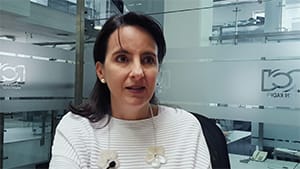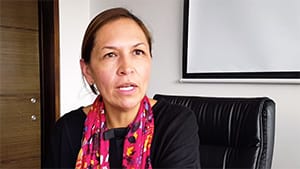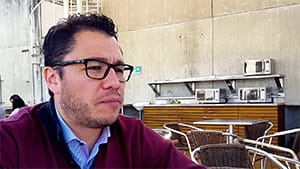Colombia
Introduction
«In Colombia, there is still great mistrust»Colombia had a population of just under 50 million in 2018 and achieved an economic output of 330 billion US dollars. According to the World Bank's classification (2018), Colombia ranks among the countries with upper middle incomes and ranks 90th in the United Nations Human Development Index. Colombia is thus classified as a highly developed country in terms of life expectancy, educational level and standard of living. However, these means-based indicators largely ignore the large income disparities that prevail in Colombia, which are reflected in a Gini coefficient of 49.7% (2017).
Colombia's foreign trade ratio was 36.8% in 2018, with the country importing goods and services worth over 69 billion US dollars and exporting over 52 billion US dollars. In the same year, foreign investment stocks amounted to 189 billion US dollars. Colombia thus accounted for 10% of direct investment in Latin America.
In 2016, the government and the guerrilla group Fuerzas Armadas Revolucionarias de Colombia (FARC) reached an agreement to end their armed conflict. The success of the peace process will also depend on whether Colombia effectively addresses the pressing social and environmental challenges facing the country. Colombia ranks 99th out of 180 in Transparency International's Corruption Perceptions Index (2019), which means that the level of corruption in the public sector is perceived as high.
In the 52 years of the civil war, guerrillas, paramilitaries and security forces repeatedly committed massive human rights violations. The 2016 peace agreement offered an opportunity to significantly curb these violations. However, Human Rights Watch (2019) notes that after initial declines related to the 2015 FARC ceasefire, violence started to rise again in 2018. Human rights defenders, trade union representatives and journalists continue to be threatened, attacked and prevented from carrying out their activities. In addition, the social and economic development opportunities of the country's indigenous population are severely limited. Malnutrition, disease and infant mortality arise as consequences. In 2019, Reporters Without Borders reported that one journalist had been killed in Colombia in connection with his activities. The country ranks 129th out of 180 countries in the Freedom of the Press ranking.

According to official statistics, 81% of the population’s municipal waste (2012) is collected and 1% thereof is being recycled (2011). 96.5% of the population have access to basic drinking water services (2015), with a significant urban-rural gap between urban areas (99.8%) and rural areas (86.0%). It is also striking that only 71.1% of the population has access to safe drinking water sources. 77% of the population are connected to the wastewater collection system (2010).
At 1.8 metric tons, CO2 emissions per capita are well below both the global average (5.0 metric tons) and the Latin American average (3.1 metric tons).
In the following, a challenge at individual company level in each area is presented, and it is described how companies are trying to implement responsible management practices in these areas.
Companies in Colombia face different challenges in terms of human rights/working conditions, the environment and corruption, which will be discussed in more detail in the following sections. In addition, examples are given of how companies fulfil their corporate responsibility in the following three areas.

Human rights
«Colombia went through a sad age»The peace agreement between the Colombian state and the guerilla organization FARC offers the chance that the violence in Colombia will decrease. However, the withdrawal of the FARC from its former territories has created a power vacuum that allows other armed groups to spread. The state was not present in the territories of the FARC and is still not fulfilling the role it would have to assume. This leaves the population in a defenseless and lawless space, where they continue to suffer violence from paramilitary organizations, illegal groups and criminal gangs.
The successful implementation of the peace process also requires the economic development of rural areas, often difficult to access, which have been dominated by the guerrilla group for decades. The private sector has an important role to play here, for example, by creating jobs or reintegrating former FARC fighters into civilian (working) life. To this end, they must receive vocational training, among other things. Even if companies cannot be given full responsibility for this, there are some examples of companies that have created a working environment with decent working conditions.
After more than 50 years of civil war, however, the private sector is also called upon to play an active role in coming to terms with the armed conflict and thus contribute to reconciliation. To this end, companies must reappraise their role in the armed conflict, for example, by participating in a national truth commission or by having historians investigate whether and how the company has cooperated with guerrilla groups or paramilitary organizations.



Environment
«Environmental protection is one of the greatest challenges facing Colombia»The Colombian agricultural sector is a sector that faces many challenges in terms of environmental protection. Pesticides classified by the World Health Organization as toxic and carcinogenic are used in industrial flower production. Due to a lack of safety precautions, the chemicals cause diseases and contamination of the groundwater around the flower plantations.
In the agro-industry, however, there are also examples of companies that are actively committed to environmental and climate protection. For example, a Colombian family business in the beverage and sugar industry invested millions in new technologies to reduce its environmental impact. For instance, modern chimney systems were installed to filter the majority of pollutants from the exhaust air; as well as irrigation systems were purchased to reduce the waste of water to a minimum. In addition, the company sells sugar cane press residues to companies that make paper from them. Other processing residues are used to produce ethanol, which is used for energy production. This way, the company attempts to recycle or reuse as many materials as possible.


Corruption
«The informal sector is a tragedy for Colombia»The Colombian economy is characterized by a high degree of informality. The majority of employees work in the informal sector. A distinction is made between informal and illegal enterprises. Informal companies basically operate in accordance with the rules but are not registered with the Chamber of Commerce. In principle, however, they could be registered. On the contrary, illegal companies are those that engage in activities that cannot be authorized because they operate, for example, in areas that are under nature conservation. On the one hand, the companies perceive formalization as an unnecessarily large bureaucratic effort; on the other hand, there is a widespread belief that those who pay taxes will be robbed. . In addition, the companies orient themselves to their surroundings. If they also work informally and are not punished, then why change something?
For multinational companies and local companies in the formal sector, the high level of informality poses considerable challenges. This is particularly the case when companies are implementing projects in rural areas, where the level of informality is particularly high. Nevertheless, even in this case there are examples of companies that are able to ensure that only formal companies are active in their supply chain.
On the one hand, companies achieve this by bringing formal suppliers from large cities to rural areas, even if this often proves to be very inefficient due to the large geographical distances. On the other hand, the companies also develop suppliers from rural areas and lead them to the formality. Some companies include these development tasks in their project calculations. The involvement of local companies in the project work has the positive additional effect that it significantly increases the acceptance of the project among the local population.
Conclusion
